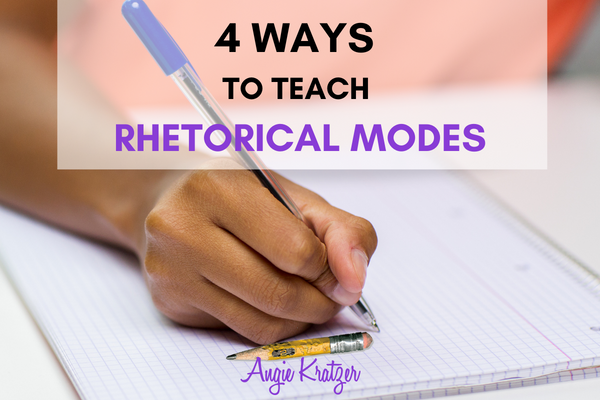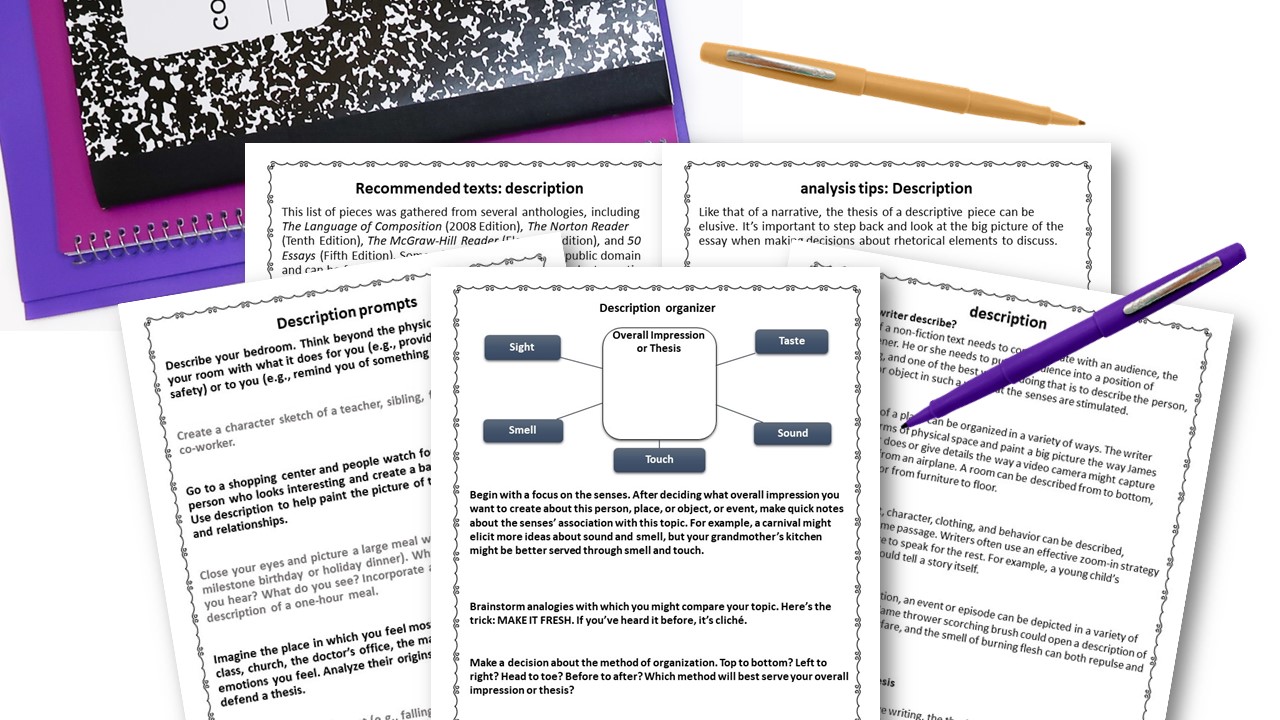Rhetorical modes. Modes of discourse. Writing genres. These terms are often interchangeable and refer to four main categories—narration, description, argumentation/persuasion, and exposition.
Argumentation and persuasion, at least for the AP English Language & Composition course, is a stand-alone set of modes, one that must be taught explicitly and with depth. On the exam students will write at least two persuasive essays (arguably three since even rhetorical analysis sets up a thesis) and analyze them as well on the multiple-choice section. The passage for the rhetorical analysis essay may be a persuasive piece itself. In short, argumentation and persuasion get their own big, big slice of the AP Lang pie.
Narration and description are their own categories as well and are often the most fun to write and most difficult to analyze. Their theses are usually more subtle, thus making them a challenge for less experienced readers and writers.
Exposition is a strange one. It breaks out into comparison-contrast, extended definition, classification and division, cause and effect, and process analysis. In AP world, I think of these as mini modes, frames that students may analyze on the exam but that they will not likely be asked to produce. Students should learn to write in these modes anyway. What better way to wrap your head around a concept than to produce within that framework?
But we’re not done with exposition. Add within that broader mode rhetorical analysis and literary analysis, the big dogs of any English/Language Arts curriculum. I handle those separately and extensively.
So how in the world do we get all this in? There are several ways to go about it. In an earlier blog post, 5 Approaches to Rhetorical Analysis, I discuss analysis itself, but there’s more to the modes than just picking them apart. Students should be able to recognize them, break them down, and write within them. Here are several ways to manage all of that.

Method 1: Isolate the instruction for each rhetorical mode.
If you’ve been following me for a while, you know that I’m a pretty linear thinker, so this method works well for me. I stop the world, teach the content and skills, and move on to the next mode. My thinking on this has evolved a bit, and here’s the latest iteration: For each mode, I have the following elements in my tool box:
- A straightforward handout
- A graphic organizer
- A list of simple prompts
- A rubric to set up expectations
- A set of model essays (also known as mentor texts)
- A tips sheet for the analysis of essays within that mode
Want a sampler of my rhetorical mode materials? Click here to drop me your email address here and get an eight-page freebie.
In short, students learn about the mode, write in the mode, and then learn to analyze more complex texts written in that mode. Along the way, I also address the use of the mode as both rhetorical strategy and a rhetorical device (think macro versus micro). I recently published a resource that helps teachers walk through this process. Check out 7 Rhetorical Modes.
Method 2: Put the lion’s share of the research and planning on students.
Through a rhetorical mode group project, students take ownership of the learning. Though still isolated, this method introduces students to each mode in a more cursory way that sets them up for teacher-led direct instruction later.
Here’s how it works: A team of three or four students is assigned one of seven modes (skip argumentation and persuasion for this project). The team is responsible for researching the mode, developing a handout, choosing two models for the class to read, creating a short reading assessment so that students are held accountable for the reading, and teaching the class about the mode. The group creates a prompt and assigns it to the class, and students produce an essay that then goes to the teacher for evaluation. I used this approach for years, and students enjoyed it for several reasons. It gives them a break from me, they are more engaged in the instruction, and they get to create six to seven creative pieces. (I allow them to choose which six essays to write, and they create a portfolio of for me.)
Method 3: Weave all the modes into one unit on a longer work.
In this day of teaching excerpts and pieces of longer works for fear of running out of time, boring our students, or NOT preparing them for short-passage end-of-course assessments, we are missing out on an opportunity to weave in all the skills we need to teach. (A friend of mine blogged about this very thing. Check out Room 213’s post about the dangers of not teaching longer works.)
We really can use novels, long essays, essay collections and other extensive works to get in all the content and skills we need to teach.
Here’s what it might look like: Within a longer work of creative nonfiction like The Things They Carried or an essay collection like In Search of Our Mother’s Gardens, incorporate instruction in all the modes. One chapter or essay might use narration beautifully as a strategy or device, so that’s a perfect time to talk about that mode, practice analyzing a piece in that mode, and write in that mode.
Method 4: Weave the modes into themed or chronological units.
If your preferred method of instruction is more holistic, you have your work cut out for you in terms of making sure you get it all in. I envision it as something like this: Within a unit on war, incorporate essays from two different rhetorical modes (or modes of discourse). It is here that students learn the elements of those two modes, learn to analyze them, and learn to write in them. Including argumentation and persuasion and rhetorical analysis, you might have nine modes to address, so the planning of four or five thematic units should include all the modes.
There we have it: Four ways to teach the rhetorical modes.
Want a free mini unit on one of the modes? Grab this descriptive mode pack.


